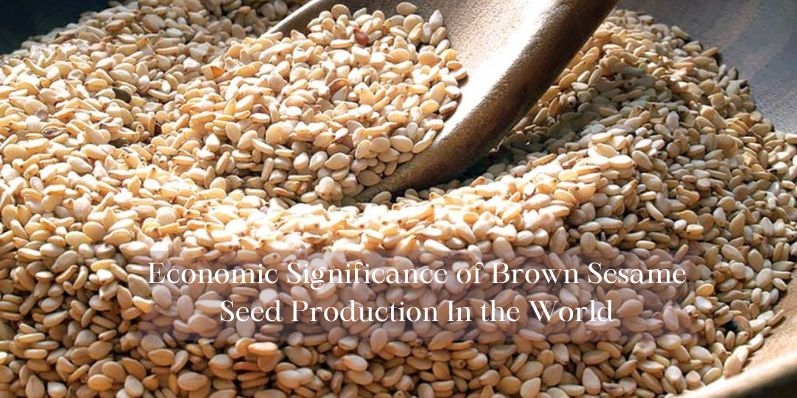
14-01-2024
Economic Significance of Brown Sesame Seed Production In the World
- Admin
Introduction
Sesame seeds, often considered a tiny powerhouse of nutrients, have been an integral part of global cuisines for centuries. While white sesame seeds are more commonly known, the economic significance of brown sesame seed production has been steadily gaining recognition. This blog delves into the market dynamics, economic impact on the agricultural sector, export-import dynamics, price fluctuations, and investment opportunities surrounding brown sesame seeds, with a special focus on Australia's role in this burgeoning industry.
Market Demand and Trends: Global Brown Sesame Seed Trade
In recent years, the global demand for brown sesame seeds has witnessed a notable surge, driven by changing consumer preferences and an increasing awareness of their health benefits. Brown sesame seeds are prized for their higher oil content and distinct flavor profile, making them a sought-after ingredient in various culinary applications. The Middle East, Asia, and North America are among the key regions contributing to the rising demand.
Australia, with its conducive climate and advanced agricultural practices, has emerged as a significant player in the global brown sesame seed trade. The country's commitment to sustainable farming methods has positioned it as a reliable source of high-quality sesame seeds, meeting the discerning standards of international markets.
Economic Impact on the Agricultural Sector
The cultivation of brown sesame seeds has brought about a positive economic impact on Australia's agricultural sector. The crop's resilience to harsh conditions and its ability to thrive in arid regions make it an attractive option for farmers, contributing to crop diversification. This diversification not only enhances farmers' income but also strengthens the overall resilience of the agricultural landscape against unforeseen challenges.
Furthermore, the rotational benefits of brown sesame seed cultivation, such as improved soil health and pest management, add value to the broader agricultural ecosystem. As a result, Australia's agricultural sector stands to gain both economically and environmentally from the increasing prominence of brown sesame seed production.
Export and Import Dynamics of Brown Sesame Seeds
Australia's participation in the global brown sesame seed trade is marked by its status as a net exporter. The country's commitment to maintaining stringent quality standards ensures that its sesame seeds are well-received in international markets. Major importing countries include those in the Asia-Pacific region, the Middle East, and North America.
The export dynamics of brown sesame seeds contribute significantly to Australia's trade balance, fostering economic growth. As global demand continues to rise, Australia's strategic position in the southern hemisphere provides a steady supply of sesame seeds during different seasons, aligning with the diverse requirements of importing nations.
Price Fluctuations and Stability Factors Affecting Brown Sesame Seed Economy
Like any agricultural commodity, brown sesame seeds are subject to price fluctuations influenced by various factors. Climatic conditions, geopolitical events, and changes in global demand are some of the variables that can impact sesame seed prices. Australia, with its proactive risk management strategies and diversified agricultural portfolio, is well-positioned to navigate these fluctuations.
Stability in the brown sesame seed economy is further bolstered by the increasing adoption of technology in farming practices. Precision agriculture, sustainable irrigation methods, and data-driven decision-making contribute to enhanced productivity and mitigate risks associated with price volatility.
Opportunities and Challenges of Investment in Brown Sesame Seed Production
Investing in brown sesame seed production in Australia presents a myriad of opportunities and challenges. The growing global demand, coupled with Australia's expertise in sustainable agriculture, creates a favorable environment for investors. However, challenges such as climate variability, market competition, and the need for continuous innovation in farming practices necessitate a thorough understanding of the industry.
Government incentives, research and development initiatives, and collaborations between stakeholders can play a pivotal role in overcoming these challenges. Investors keen on tapping into the economic potential of brown sesame seed production in Australia should prioritize sustainable practices, technological integration, and market intelligence to ensure long-term success.
Conclusion
The economic significance of brown sesame seed production is undeniably on the rise, driven by shifting consumer preferences and a growing awareness of the crop's nutritional benefits. Australia, with its commitment to sustainable farming practices and strategic geographic position, has emerged as a key player in the global brown sesame seed trade.
The impact on Australia's agricultural sector, export-import dynamics, price stability measures, and investment opportunities collectively contribute to the narrative of a thriving industry. As the world continues to recognize the value of brown sesame seeds, Australia stands poised to play an integral role in meeting the global demand for this versatile and economically significant crop.